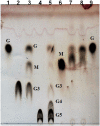Valorization of Biomasses from Energy Crops for the Discovery of Novel Thermophilic Glycoside Hydrolases through Metagenomic Analysis
- PMID: 36142415
- PMCID: PMC9505709
- DOI: 10.3390/ijms231810505
Valorization of Biomasses from Energy Crops for the Discovery of Novel Thermophilic Glycoside Hydrolases through Metagenomic Analysis
Abstract
The increasing interest for environmentally friendly technologies is driving the transition from fossil-based economy to bioeconomy. A key enabler for circular bioeconomy is to valorize renewable biomasses as feedstock to extract high value-added chemicals. Within this transition the discovery and the use of robust biocatalysts to replace toxic chemical catalysts play a significant role as technology drivers. To meet both the demands, we performed microbial enrichments on two energy crops, used as low-cost feed for extremophilic consortia. A culture-dependent approach coupled to metagenomic analysis led to the discovery of more than 300 glycoside hydrolases and to characterize a new α-glucosidase from an unknown hyperthermophilic archaeon. Aglu1 demonstrated to be the most active archaeal GH31 on 4Np-α-Glc and it showed unexpected specificity vs. kojibiose, revealing to be a promising candidate for biotechnological applications such as the liquefaction/saccharification of starch.
Keywords: CAZymes; archaea; enrichments; extremozymes.
Conflict of interest statement
The authors declare they have no conflict of interest.
Figures






Similar articles
-
Discovery of genes coding for carbohydrate-active enzyme by metagenomic analysis of lignocellulosic biomasses.Sci Rep. 2017 Feb 15;7:42623. doi: 10.1038/srep42623. Sci Rep. 2017. PMID: 28198423 Free PMC article.
-
Glycoside hydrolases from (hyper)thermophilic archaea: structure, function, and applications.Essays Biochem. 2023 Aug 11;67(4):731-751. doi: 10.1042/EBC20220196. Essays Biochem. 2023. PMID: 37341134 Review.
-
Glycoside Hydrolases and Glycosyltransferases from Hyperthermophilic Archaea: Insights on Their Characteristics and Applications in Biotechnology.Biomolecules. 2021 Oct 21;11(11):1557. doi: 10.3390/biom11111557. Biomolecules. 2021. PMID: 34827555 Free PMC article. Review.
-
Characteristics, protein engineering and applications of microbial thermostable pullulanases and pullulan hydrolases.Appl Microbiol Biotechnol. 2016 Jul;100(13):5661-79. doi: 10.1007/s00253-016-7572-y. Epub 2016 May 3. Appl Microbiol Biotechnol. 2016. PMID: 27142298 Review.
-
Bioprospecting metagenomics for new glycoside hydrolases.Methods Mol Biol. 2012;908:141-51. doi: 10.1007/978-1-61779-956-3_14. Methods Mol Biol. 2012. PMID: 22843397
Cited by
-
Genomic insights into Thermomonas hydrothermalis: potential applications in industrial biotechnology.World J Microbiol Biotechnol. 2025 Jan 11;41(2):30. doi: 10.1007/s11274-024-04240-3. World J Microbiol Biotechnol. 2025. PMID: 39794628
-
Report on the 23rd FEBS Young Scientists' Forum 2024.FEBS Open Bio. 2024 Dec;14(12):1934-1939. doi: 10.1002/2211-5463.13933. FEBS Open Bio. 2024. PMID: 39618389 Free PMC article.
-
Integrating multi-platform assembly to recover MAGs from hot spring biofilms: insights into microbial diversity, biofilm formation, and carbohydrate degradation.Environ Microbiome. 2024 May 6;19(1):29. doi: 10.1186/s40793-024-00572-7. Environ Microbiome. 2024. PMID: 38706006 Free PMC article.
-
Carbohydrate conversion in spent coffee grounds: pretreatment strategies and novel enzymatic cocktail to produce value-added saccharides and prebiotic mannooligosaccharides.Biotechnol Biofuels Bioprod. 2025 Jan 7;18(1):2. doi: 10.1186/s13068-024-02601-6. Biotechnol Biofuels Bioprod. 2025. PMID: 39773291 Free PMC article.
-
Mining thermophiles for biotechnologically relevant enzymes: evaluating the potential of European and Caucasian hot springs.Extremophiles. 2023 Nov 22;28(1):5. doi: 10.1007/s00792-023-01321-3. Extremophiles. 2023. PMID: 37991546 Free PMC article. Review.
References
MeSH terms
Substances
LinkOut - more resources
Full Text Sources
Molecular Biology Databases

